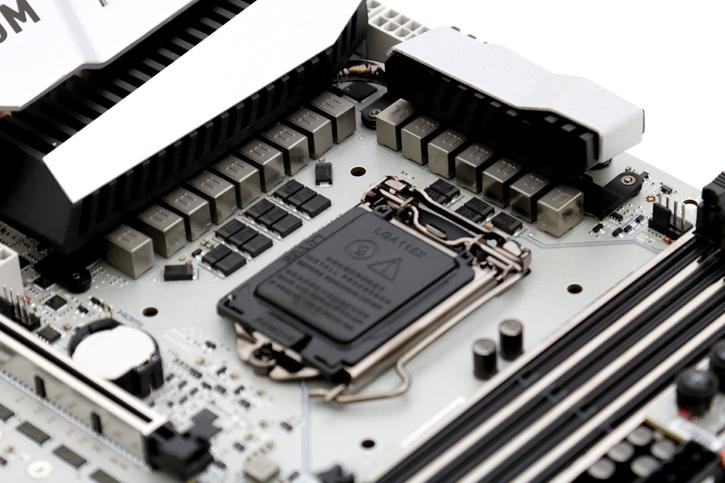PCH - The Platform Controller Hub Chipsets
PCIe Lanes
With PCIe Gen 3.0 compatible processors and platforms can feature 16 PCIe 3.0 lanes to be used for graphics and/or other add-in PCI cards. All desktop chipsets have a single PCIe x16 device, the Z270 chipset adds the option to use two devices at 16. Simply put, PCI Express Gen 3 provides a 2x faster transfer rate than the previous generation, this delivers capabilities for next generation extreme gaming solutions. PCI Express Gen 3 has twice the available bandwidth, 32 GB/s, improved efficiency and compatibility and as such it will offer better performance for current and next gen PCI Express cards. Going from PCIe Gen 2 to Gen 3 doubles the bandwidth available to the add-on cards installed, from 500 MB/s per lane to 1 GB/s per lane. So a Gen 3 PCI Express x16 slot is capable of offering 16 GB/s (or 128 Gbit/s) of bandwidth in each direction. That results in 32 GB/sec bi-directional bandwidth. Obviously the hardware you use needs to be compatible.
M.2 Storage Units
You've read our reviews, NVMe and M.2 storage is seriously fast. Most, if not all H270 and Z270 motherboards will likely all have that cute and tiny M.2 PCIe interface. That brings small form factor add-in SSDs to our desktop PC platform. There is an abbreviation for that, NGFF (Next Generation Form Factor). It is not just that though, SATA3 has not been among us for that long, but the SSDs evolved in a very fast manner, making SATA3 already a bottleneck for current generation SSDs. M.2 PCIe links directly to your PCIe lanes and as such is considered to be a PCI-Express unit, it is an interface with much more available bandwidth. At a cool 10 Gbps, PCI-Express based M.2 has roughly 67% more bandwidth available opposed to SATA3 (6 Gbps). Next to that, all motherboard manufacturers now offer x4 links, generating 32 Gbit/s connectivity. This has ignited a new SSD race. You can expect performance in the 700 MB/sec up-to 3000MB/sec range with these products.
Optane Storage Units
There's more news on the storage front, the 200 series chipset will be the first to support Intel Optane, previously referred to as 3D XPoint (3D Crosspoint) technology, it was was announced back in 2015 with the story it could be up-to 1000x faster than conventional NAND memory. Intel developed Optane storage memory in collaboration with Micron. It combines the raw speed of system memory with the storage capacity of flash memory. It is a form of phase change memory, in which individual cells or bits as can be addressed individually like DRAM, in flash memory cells are always a string read out and described by block. Initially 128Gbit chips should be released, which are built around a Crosspoint Array Structure, which can be addressed to 128 billion memory cells. Optane actually makes use of the new NVMe protocol. An early prototype was already demonstrated at IDF and would offer up-to 5.5 times the throughput of NAND flash-based DC P3700 series SSDs, (engineering sample and thus early development). Compared to the queue depth of just 32 commands for AHCI, NVMe offers a command queue depth of 65,535 commands. Micron is the co-developer of 3D Xpoint so you may expect Crucial branded SSD drives based on this technology as well. New information has been spotted (not necessarily exciting) as Intel will release two initial Optane Memory 8000p products based on the new technology at launch, a 16GB and 32GB 3D XPoint storage unit is planned based on M.2 2280 and 2241 form factors. The units would thus use PCI-E 3.0. The 32GB model would reach 1600 MB/s on reads and 500 MB/s on writes whereas the 16GB model would reach 1400 MB/sec and 300 MB/sec. IOPS reads are 300K and 285K respectively with 120K and 70K on writes. You'll need a Kaby Lake processor and compatible series 200 chipset to be able to run these Optane Memory 8000p units.
SuperSpeed+ USB
USB 3.0 Gen 1 (also known as SuperSpeed USB) has a maximum bandwidth rate of 5 gbps (gigabits per second). That would be to 625 MBps (megabytes per second), ten times faster than USB 2.0 (aka Hi-Speed USB). USB 3.1 (now known as SuperSpeed+ USB) however once again doubles the numbers and jumps from 5 to 10 Gbps. On the now slowly accustomed USB 3.0 SuperSpeed interface you will be pretty much maxing out in the 400 to 450 MB/sec threshold due to a lot of factors. With USB 3.1 you could hover in the 700 Mb/sec range if you have a storage device that supports USB 3.1 though, as that obviously is a requirement. USB 3.0 was called SuperSpeed USB, and SuperSpeed+ USB will be the name for USB 3.1.
ALL USB solutions are backwards compatible, meaning you can use USB 1.x, 2.0 and 3.0 devices on this USB 3.1 interface just as well. Below we placed the specifications in-between USB standards in a chart.
| USB 1.x | USB 2.0 | USB 3.0 | USB 3.1 | |
|---|---|---|---|---|
| Branding | Full Speed | Hi-Speed | SuperSpeed | SuperSpeed+ |
| Bandwith | 12 Mbps | 480 Mbps | 5.0 Gbps | 10.0 Gbps |
| Encoding | 8b/10b | 8b/10b | 8b/10b | 128b/132b |
| Data speed | 1,2 MB/s | 48 MB/s | 625 MB/s | 1250 MB/s |
LGA 1151 - The CPU Socket
With Sandy Bridge we moved to socket LGA 1155 and for Ivy Bridge we kept that socket. Haswell and Broadwell fit onto socket LGA 1150. For Skylake there is one more pin in use, socket 1151 was the new socket to use, Kaby Lake shares this socket. The good news is that the cooler pins are similar to 1150/1155/1156 so you can re-use your cooler. So, you do not need to purchase a new CPU cooler.



